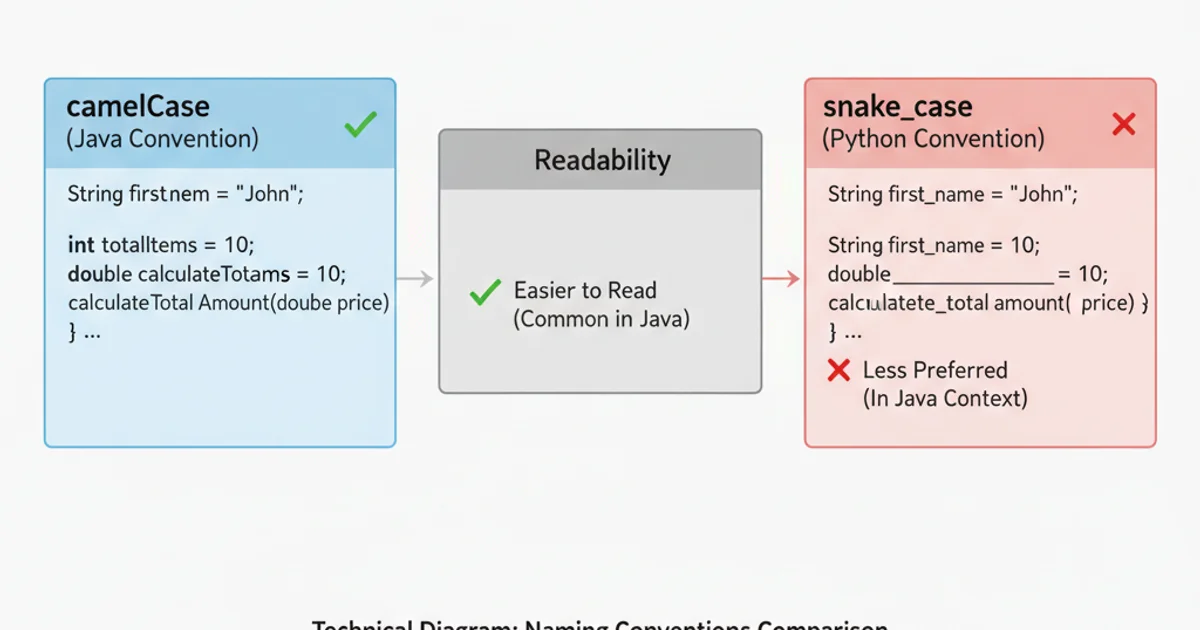To camelCase or not to camel_case
Categories:
To camelCase or not to camel_case: Navigating Java Naming Conventions

Explore the nuances of camelCase and snake_case in Java, understand the community's preferred style, and learn how consistent naming improves code readability and maintainability.
Naming conventions are a cornerstone of readable and maintainable code. In the Java ecosystem, a strong preference for camelCase has emerged over alternatives like snake_case. This article delves into why camelCase is the de facto standard in Java, when and where it applies, and the benefits of adhering to these established guidelines. We'll also touch upon the historical context and the impact of consistent naming on collaboration and code quality.
The Java Standard: camelCase Everywhere
Java's official coding conventions, as outlined by Oracle (formerly Sun Microsystems), strongly advocate for camelCase for most identifiers. This includes variable names, method names, and even package names (though with slight variations). The core principle is to start with a lowercase letter and capitalize the first letter of each subsequent word. This convention is deeply ingrained in the Java Development Kit (JDK) itself and is followed by virtually all major Java libraries and frameworks.
public class UserProfileManager {
private String userName;
private int userAge;
public void calculateTotalScore(int score1, int score2) {
int totalScore = score1 + score2;
// ... logic
}
}
Example of camelCase for class, variable, and method names in Java.
Why camelCase? Readability and Consistency
The primary reason for camelCase's dominance in Java is readability. When identifiers are consistently named, developers spend less time deciphering their meaning and more time understanding the logic. camelCase avoids the visual clutter of underscores, which can sometimes make long identifiers harder to scan quickly. Furthermore, consistency across the vast Java ecosystem means that developers can move between projects and teams with minimal friction, as the naming patterns are familiar.

Visual comparison of camelCase vs. snake_case readability.
camelCase is standard, remember that constants (final static fields) are typically named in SCREAMING_SNAKE_CASE (e.g., MAX_ATTEMPTS). This is a common exception to the camelCase rule and helps distinguish constants at a glance.When to Deviate (and When Not To)
While camelCase is the strong default, there are specific contexts where other conventions might appear or even be appropriate:
- Constants: As mentioned,
SCREAMING_SNAKE_CASEis used forstatic finalfields. - External Systems: When interacting with databases or APIs that use
snake_case(e.g., JSON payloads, SQL column names), you might seesnake_casein DTOs or mapping layers. However, even then, the Java convention is often to convert these tocamelCaseinternally as soon as possible. - Legacy Code: Older codebases might not strictly adhere to modern conventions. When working with such code, it's often best to maintain the existing style within that specific module to avoid introducing inconsistency, unless a full refactoring is planned.
Generally, for new Java code, sticking to camelCase is the safest and most recommended approach.
public class Configuration {
public static final int MAX_RETRIES = 5;
public static final String DEFAULT_FILE_PATH = "/tmp/data";
// ... other fields and methods
}
Example of SCREAMING_SNAKE_CASE for constants.